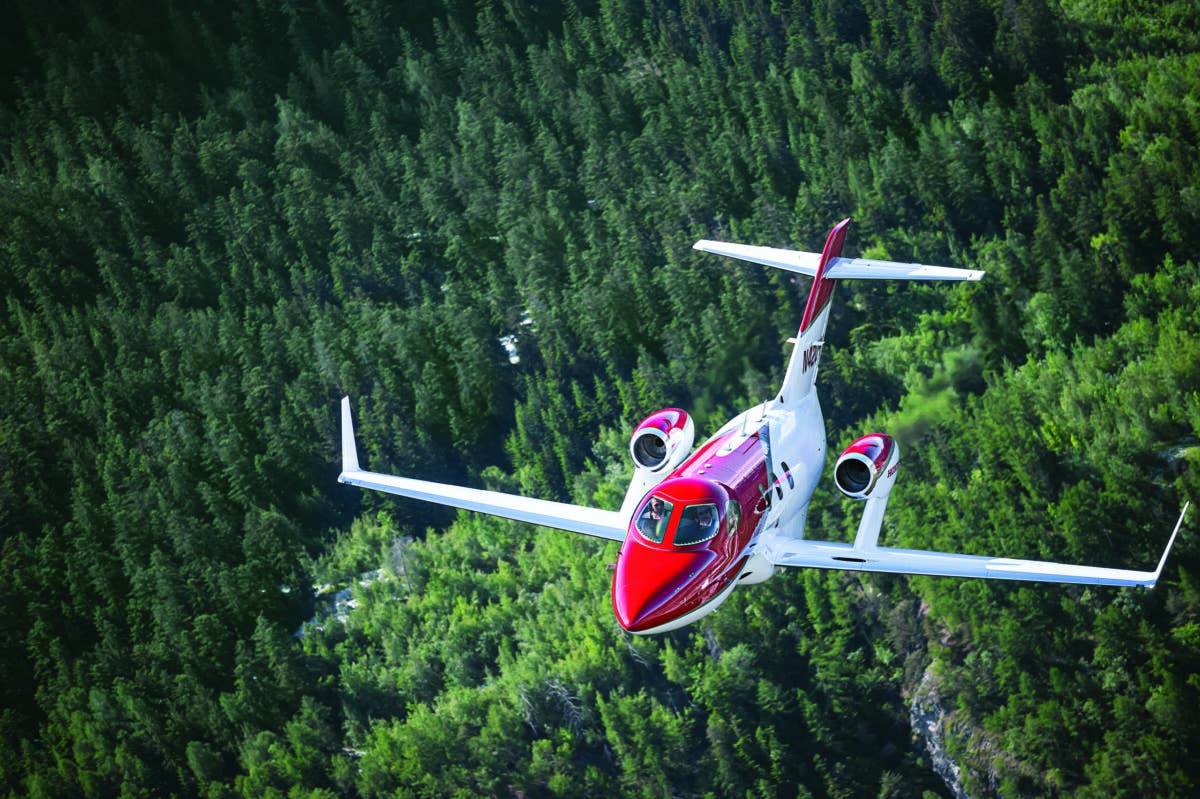NTSB Releases Fiery HondaJet Runway Excursion Details
The pilot told NTSB investigators that despite applying full brake pressure, ‘very little braking effort was being done to slow the plane.’

Honda Aircraft’s HA-420 [Courtesy: Honda Aircraft]
The National Transportation Safety Board (NTSB) has released the preliminary report into last month's runway overrun of a HondaJet at Summerville, South Carolina. There were no injuries, but the jet was destroyed by fire.
According to the NTSB, on May 17 HondaJet N255HJ departed Wilkes County Airport (KUKF) North Wilkesboro, North Carolina, just before midnight with the intent of landing at Summerville Airport (KDYB) in South Carolina, a distance of approximately 193 nm.
The pilot, who held a commercial certificate, filed an IFR flight plan with the intent of flying the RNAV 24 approach to land at KDYB. The pilot told investigators he noted there were rainstorms in the vicinity, so he opted to delay the departure until 23:29 local time to let the storms pass. The pilot stated he realized the runway at KDYB would be wet because of the rain but was not concerned since he had landed at the airport "hundreds" of times on both a wet and dry runway, and had never experienced an issue with runway length before.
According to AirNav.com, runway 6/24 at KDYB measures 5,000 feet by 75 feet. The approach to Runway 24 has a 79-foot-tall tree located approximately 1,560 feet from the runway and 221 feet right of centerline. The notes advise a 17:1 slope is necessary to clear it. In addition, the approach information for the RNAV (GPS) 24 indicates a glideslope of 3.04 degrees is necessary to clear obstacles. The standard glideslope for instrument approaches is 3.00 degrees. According to Aircraft Owners and Pilots Association's Flightplanner, Runway 6 at KDYB has a 0.3 percent downslope and non-precision markings.
The pilot told investigators the winds were calm as he flew the RNAV (GPS) RWY 24 approach into KDYB coupled with the autopilot, until the aircraft was approximately 600 feet msl. At that altitude the pilot opted to hand fly the approach at 120 knots with full flaps. He intended to bring the aircraft to a stop in order to exit the runway at the second taxiway.
Upon touchdown he applied full brake pressure and noticed the brakes "immediately began to pulsate in anti-skid mode and because of that, very little braking effort was being done to slow the plane despite full pedal pressure.”
The pilot noted the response of the anti-skid system exhibited a slower on/off cycle than he had experienced before during wet runway landings. The jet was about halfway down the runway when the pilot noted it was apparent he would not be able to exit at the second taxiway as planned, but he was not concerned as he felt there was sufficient runway to bring the aircraft to a stop, saying it had always stopped with reserve length remaining even when the runway was wet.
The pilot was considering aborting the landing, then the left brake "grabbed" and the nose of the aircraft suddenly yawed to the left. The airplane began to skid to the left and right. The pilot attempted to use the rudder pedals to keep the jet on the runway, saying he was able to straighten the nose out right before the aircraft went off the departure end of the runway and into the grass.
The airplane slid down a series of embankments before coming to a stop and catching fire. The pilot and all five passengers were able to exit through the main cabin door.
The fire consumed the aircraft cockpit, center fuselage, and the right wing.
NTSB Investigation
The on-scene investigation was conducted on May 19. Investigators noted all major components of the airplane were accounted for at the accident site.
There were skid marks on the runway from the airplane's tires that, according to investigators, "were chalky in appearance and appeared similar to other normal airplane tire marks on the runway." The tire marks from the accident aircraft were S-shaped and traced backward 1,550 feet from the departure end of the runway to the area near taxiway C intersection.
It was noted that approximately 275 feet before the departure end of the runway, the tire tracks indicated the aircraft drifted into the grass on the left side of the runway then back to the paved surface. At one point, the nose landing gear and right main landing gear tracks converged.
During the off-runway excursion the airplane struck a departure end runway light, traveling another 273 feet before it went down a 10-foot embankment and struck a rocky berm. The aircraft then slid down another 6-foot embankment before coming to rest approximately 360 feet from the departure end of the runway.
Damage to the Aircraft
According to the NTSB the right wing of the aircraft exhibited "extensive impact and fire damage," so much so that the flap setting at the time of the accident could not be confirmed. The left wing was largely undamaged, except for impact marks along the leading edge from the collision with the rocky berm. The left flap was found fully extended. The rudder, elevator, vertical and horizontal stabilizer were undamaged. Investigators noted the aft empennage-mounted speed brake was in the fully retracted position.
NTSB said the investigation remains ongoing, and the final report is expected in about 18 to 24 months.

Sign-up for newsletters & special offers!
Get the latest FLYING stories & special offers delivered directly to your inbox






